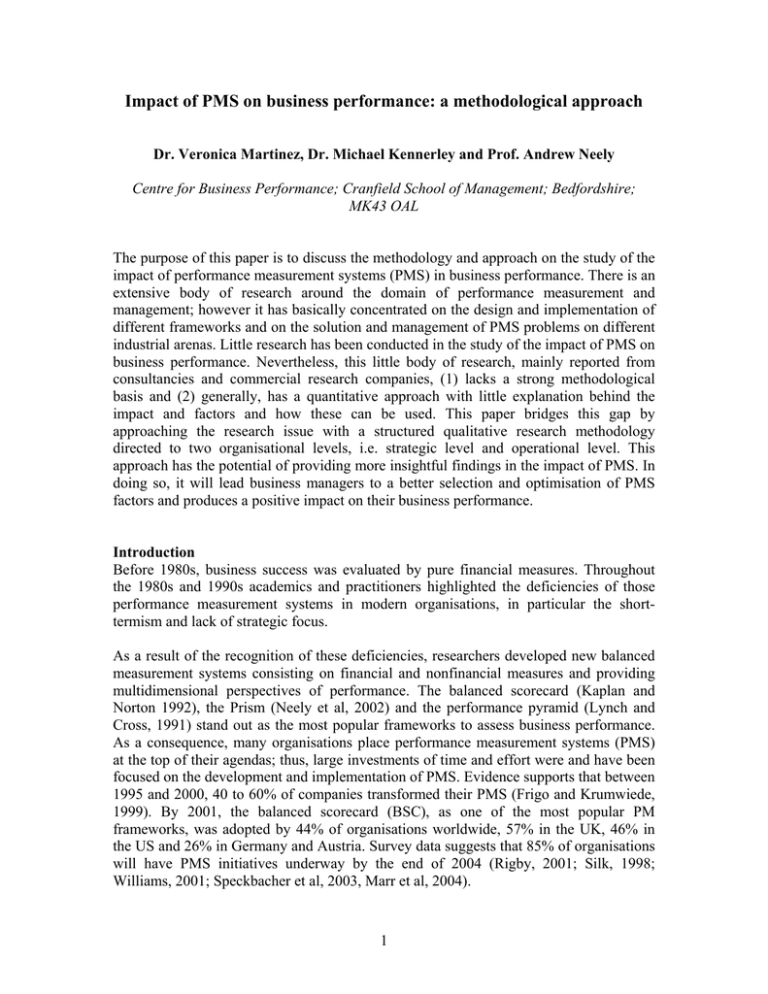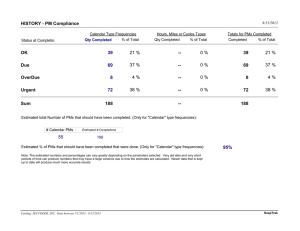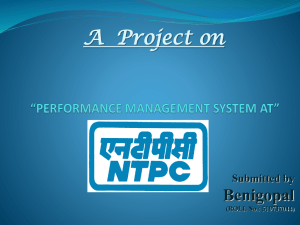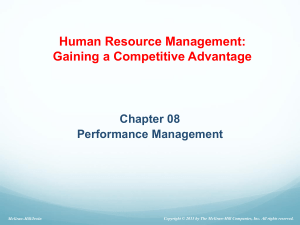Impact of PMS on business performance: a methodological approach
advertisement

Impact of PMS on business performance: a methodological approach Dr. Veronica Martinez, Dr. Michael Kennerley and Prof. Andrew Neely Centre for Business Performance; Cranfield School of Management; Bedfordshire; MK43 OAL The purpose of this paper is to discuss the methodology and approach on the study of the impact of performance measurement systems (PMS) in business performance. There is an extensive body of research around the domain of performance measurement and management; however it has basically concentrated on the design and implementation of different frameworks and on the solution and management of PMS problems on different industrial arenas. Little research has been conducted in the study of the impact of PMS on business performance. Nevertheless, this little body of research, mainly reported from consultancies and commercial research companies, (1) lacks a strong methodological basis and (2) generally, has a quantitative approach with little explanation behind the impact and factors and how these can be used. This paper bridges this gap by approaching the research issue with a structured qualitative research methodology directed to two organisational levels, i.e. strategic level and operational level. This approach has the potential of providing more insightful findings in the impact of PMS. In doing so, it will lead business managers to a better selection and optimisation of PMS factors and produces a positive impact on their business performance. Introduction Before 1980s, business success was evaluated by pure financial measures. Throughout the 1980s and 1990s academics and practitioners highlighted the deficiencies of those performance measurement systems in modern organisations, in particular the shorttermism and lack of strategic focus. As a result of the recognition of these deficiencies, researchers developed new balanced measurement systems consisting on financial and nonfinancial measures and providing multidimensional perspectives of performance. The balanced scorecard (Kaplan and Norton 1992), the Prism (Neely et al, 2002) and the performance pyramid (Lynch and Cross, 1991) stand out as the most popular frameworks to assess business performance. As a consequence, many organisations place performance measurement systems (PMS) at the top of their agendas; thus, large investments of time and effort were and have been focused on the development and implementation of PMS. Evidence supports that between 1995 and 2000, 40 to 60% of companies transformed their PMS (Frigo and Krumwiede, 1999). By 2001, the balanced scorecard (BSC), as one of the most popular PM frameworks, was adopted by 44% of organisations worldwide, 57% in the UK, 46% in the US and 26% in Germany and Austria. Survey data suggests that 85% of organisations will have PMS initiatives underway by the end of 2004 (Rigby, 2001; Silk, 1998; Williams, 2001; Speckbacher et al, 2003, Marr et al, 2004). 1 Investments are based on the hypothesis that the use of ‘balanced’ performance measurement systems has a positive impact on the performance of the organisation. Evidence from a research carried out in 2000-2001 by three Austrian academics, which followed a rigorous research methodology (in contrast to evidence presented from consultants), reported that 8% of 174 Companies from German speaking countries decided not to implement a PMS (in particular the BSC) because they do not see advantages or ‘positive impact’. Moreover some of them consider that the introduction of BSC demands too much effort and the return (benefits) are still unsure (Speckbacher et al, 2003). From theory, there is relatively little research, with no in-depth academic basis, which tests the hypothesis or evidence that there is a positive return for the investment (Kennerley and Bourne, 2003; Franco and Bourne, 2003). Even less investigation has been done on the identification of factors that lead to a positive impact of PMS on business results. This research is part of a 28 months research project named ‘evaluating the impact of PMS’, which is supported by an EPSRC grant [GR/S28846]. The aim of this paper is to discuss the methodology and approach on the study of the impact of PMS in business performance. The remainder of this paper is organised in five sections. Section II reviews related research on the impact of PMS. The discussion of different methodological approaches is discussed in Section III. The proposed methodology for this research is described in Section IV. Section V highlights some conclusions and discusses the implications for the body of knowledge and practice. The final section debates the limitations and future work on this research issue. Impact of PMS The extensive body of research around the domain of performance measurement and management has basically concentrated on the design and implementation of different frameworks and on the solution and management of PMS problems on different industrial arenas. As previously discussed, little research has been conducted in the study of the impact of PMS on business performance. Some survey data collected by consultancies and commercial research companies suggests that organisations managed through ‘balanced’ PMS perform better than others (Lingle and Schiemann, 1996; Gates, 1999). Early studies show some positive impact of PMS on business results. Ittner, Larcker and Randall (2003) and Lingle and Schiemann (1996) found evidence that organisations making more extensive use of financial and non-financial measures and linking strategic measures to operational measures have higher stock market returns. Furthermore, 2 Lawson, Stratton and Hatch’s study (2003) shows that the use of PMS as a management control tool reduces the overhead costs by 25% and increases sales and profits. Ittner and Larcker’s survey study (2003) reports that only 23% of 157 organisations surveyed consistently build and test causal models, but that these 23% achieved on average 2.95% higher return on assets and 5.14% higher return on equity. While interesting, the Ittner and Larcker studies draw on wide-scale survey data, which have the obvious problems associated with assessing the extent to which particular organisations really have implemented balanced scorecards. The positive impact of PMS, also called ‘the benefit of PMS’ by Lawson, Stratton and Hatch (2003) or ‘the beneficial effect of PMS’ by Malina and Selto (2001), is not an exclusive definition of businesses’ profitability or financial improvements. The positive impact of PMS also involves other type of benefits, such as development of managerial capabilities (Weinstein and Castellano, 2004), effective communication (Malina and Selto, 2001), etc. This research distinguishes two types of PMS impact: the internal impact and the external impact of PMS. • The external impact is an external expression of the company performance and is perceived by different stakeholders. Some examples of external impact are: the improvement of reputation and leadership (Anderson et al, 1994), improvement of customer satisfaction (Davis et al, 2004), the improvement of sales and market expansion (Evans, 2004; Larcker, 2004), increase income per employee (Gubman, 1998). • The internal impact of PMS is an internal expression of the company performance. It affects the company’s operational processes and is mainly perceived and experienced by the company’s employees. Among some of them are: enhance staff motivation (Godener and Soderquist, 2004), improve top management commitment (Cavalluzo and Ittner, 2004), etc. The internal impact of PMS ultimately affects the external impact of PMS; however very little research explores the sequential effects of the impacts of PMS. Frigo and Krumwiede (1999), de Waal (2003) and Sandt et al (2001) have identified some internal impact that they believe ultimately affect the business performance. They suggest that the use of highly balanced PMS facilitates well-balanced decision-making and better decisions ultimately impact business results; however there is a lack of evidence or sequential steps to support their assumption. Lawson, Stratton and Hatch (2003) and Dumond (1994) found that using PMS and linking scorecard systems to compensations and rewards significantly increases employee satisfaction. Whereas, Lingle and Schiemann (1996) and Lawson Stratton and Hatch’s evidence (2003) show that organisations updating the strategic scorecard regularly and formally tying strategy to responsibilities increase the support in changes business strategies. Ketelhohn (1998) and Vasconcellos (1988) found that the identification and selection of appropriate measures and key performance indicators enhances the implementation and 3 acceptance of the business strategy, and at the same time enhances employee understanding of the company business. The major problem, besides the little evidence reported around this research issue, is the approach taken. i.e. (1) since most research has been carried out by consultancies and commercial organisations, they lack a strong methodological basis, in other words, the validity of the research is not totally reliable. (2) Survey studies conclude that the usage of PMS increase business performance, but rarely explain why and how. They mainly focus on the financial impact and do not consider other softer issues that could bring other potential impacts. (3) At the moment, the most academic research reported takes a positivistic approach by the application of surveys. The inherent problem with this approach is that results provide very little insight to manager and practitioners, i.e. to help them identify and understand the impact of PMS and positive factors to improve business performance. Two research paradigms The main philosophical choices underlying management research are positivist paradigm and phenomenological1 paradigm. Easterby-Smith et al. (1999) defined three reasons why the understanding of the philosophical paradigms is very important. First, it helps to clarify the research design; second, it helps the researchers to recognise which designs will work and which ones will not; and third, it can help the researcher to identify and create designs that may be outside of his or her past experience. Back in 1853, Auguste Comte, an early proponent of the positivist view, stated “that there can be no knowledge but that which is based on observed facts”. The key idea of the positivist paradigm is that the social world exists externally, and that its properties should be measured through objective methods, rather than being inferred through sensations, reflections or intuition (Easterby-Smith et al, 1999). The discovery of penicillin was one of the first researches that led the scientific revolution by following a new paradigm. Fleming (1929) did not apply the scientific method but an independent and logical thinking, which provided a new way to see the world and consider other important things to investigate. This new paradigm, “phenomenology”, was born from the application of the positivist paradigm to social science (Easterby-Smith et al, 1999). Husserl (1946) stated that the phenomenological paradigm argues that the world and the reality are not objective and exterior, but they are socially constructed and given meaning by people (Burrel and Morgan, 1979:240-255). Each paradigm has advantages and disadvantages associated. Table 1 presents the strengths and weaknesses related with the phenomenological and positivistic paradigms. 1 In the latest edition of Easterby-Smith et al. book (2002), the phenomenological paradigm has been renamed as ‘social constructionism’, although its performance follows the same phenomenological approach. 4 Positivistic Phenomenological Strengths • can provide a wide coverage of different situations • can be fast and economic • can provide relevance to decision, especially when statistics of large examples are involved. Weaknesses • tend to be inflexible and artificial • not effective to understand the process or significance of people (actors) • Not very helpful in generating theories because it is focused on what is now, by inferring that changes and actions should take place in the future, but not in their research time. • understand the people’s meanings • adjust new issues to study, e.g. if there is a new issue into the research subject the researcher can address it. • contribute to the evolution of new theories • look at the change process over time • data collection is time consuming • analysis and interpretation can be difficult • some people might give it low credibility, because it is based on few experiments (Adapted from Easterby-Smith et al, 1999) Table 1 Strength and weaknesses of the positivistic and phenomenological paradigms. Since the paradigm is the foundation of the research design and source of new potential outcomes, it becomes a strategic decision. Easterby-Smith et al (1999) suggest some key choices to take into account before selecting a paradigm. Table 2 summarises the most critical choices in selecting a research posture. Key Choices Researcher’s involvement Samples Theories Methods used Positivist Phenomenological Independent Large Testing Experimental design Great involvement Small Generating Fieldwork methods (Adapted and Modified from: Easterby-Smith et al, 1999) Table 2. Paradigm’s influence on key choices of research design influenced The research issue, evaluation of the impact of PMS, established in Section 1, could be tackled with a positivist or phenomenological paradigm. In choosing, we considered the nature of research issues and its demands. As mentioned in Section 2, previous research around our research issue has taken a positivistic approach by the application of surveys (Franco and Bourne, 2003). The inherent problem to this approach is that results provide very little insight to manager and practitioners, i.e. to help them identify and understand the impact of PMS and positive factors to improve business performance. In understanding and evaluating the impact of PMS, it is important to go to the fundamental point ‘phenomenon’s root’ where impact is created and understand how it is created. This means that it is important to understand its context (internal and external factors). For these reasons, this research demands sensitivity and in-depth understanding from different fields around business, strategy, operations and even more from customers. 5 Based on the rationalisation of the research needs, the phenomenological paradigm was selected to tackle the research issue. Using Yin’s criteria (1996) for case study research, this research will be based on six case studies which will provide a richness of information. Case study can lead to creative insights, development of new theory, testing theory or exploration of a research area. Case study has been one of the most powerful research methods in operations management, particularly in the development of new theory (Voss et al, 2002). It investigates current phenomenon in the context of real time by examining the how and what questions (Yin, 1996:6-9), logically, case study tends to be more descriptive by using a wide variety of data collection techniques. Proposed Research Methodology The performance measurement value chain (PMVC) created by the Centre for Business Performance at Cranfield School of Management was developed to help organisations extract more value from their PMS (Figure 1). Once organisations created their fundamental hypothesis and models around the value they intend to deliver, they can gather data, analyse it, until they have meaningful interpretation of their performance, which allows them to make informed decisions and plan future actions (Marr, 2004:12). The PMVC proposes a logical process to analyse business performance. The beginning of the chain is focused on the development of performance insights and the end is focused on the application of performance insights. It has been applied on exploratory studies and explanatory studies. Develop Performance Insights Work with Data Hypothesis Gather Analyse Interpret Inform Make Informed Decisions Plan & Expedite Actions Apply Performance Insights Figure 1. The performance measurement value chain (PMVC) The PMVC is a framework to improve the analysis and management of performance measures based on its logical rationalisation of performance data. For this reason, the researchers found it as a suitable tool to analyse the impact of performance measurement on business results. The seven PMCV’s phases are used as generic guidelines to develop a high level process of our proposed research methodology. 6 Figure 2 summarises the proposed research methodology and distinguishes the seven PMVC phases. The point of departure of this proposed methodology begins with the development of initial insights, hypothesis and definition of the research questions (Top Figure 2). I.e. (1) Does a ‘balanced’ PMS have a positive impact on the actual performance of organisations that have implemented them? If yes, (2) What is the impact of PMS on business performance? (3) What factors do affect the impact of PMS? As previously discussed the phenomenological approach, based on case studies, was selected as the most appropriate method to investigate this research issue. Hence, the development of the research methodology was developed around the case study method. The construction of the research tools started with the development of the case study protocol and pilot questionnaires (Top Figure 2). At the moment, this research is focused on the application of the pilot case in an electrical supplier company. The results and feedback from this case will enrich the quality of tools and research insights. This research aims the application of six in-depth case studies. They will be done in two stages: Stage 1 is focused on the major strategic fields of the organisation, i.e. the study of impact and factors on organisational strategy, marketing, finances, HR, etc. and it is directed to senior managers. Stage 2 is focused on operational fields of the organisation. For instance, manufacturing, logistics, services, etc. this is directed to middle managers team leaders and measurement’s owners. The data gather will be reduced and display by using a cross-case analysis and standard data analysis tools (See Figure 2). The interpretation phase will follow the rationalisation and explanation process until the relevant findings and conclusions are drawn. These findings will be disseminated and lead us to narrow research issues for future studies. To build validity on the proposed methodology, it is supported with Miles and Huberman’s model flow (1984:21-23). Their model has four processes, i.e. data collection, reduction, display and interpretation processes. It support most of phases of our proposed methodology; i.e. from the construction of the research tools to the interpretation and phase (Figure 2). The novelties of this approach are: • The study of internal and external impact of PMS. We refer as ‘internal impact’ as the impact of PMS in the business operations and capabilities and ‘external impact’ as the impact perceived by stakeholders, such as reputation, profitability, etc. It is achieved by the application of the cases studies following the two stages above described. • This methodology will allows us to explore the sequential effects of the internal impact of PMS, in which almost no research has been conducted. • Interviewing team leaders and measurement owners (Stage 2) is a somewhat original approach, compared to most studies on the impact of PMS. 7 Our proposed methodology provides a structured research path for the study of the impact of PMS in business results by defining the research steps and tools and techniques. The methods and techniques selected aim to gather insightful data from diverse operations, strategic and tactical activities and their context. Case studies The case studies are based on interviews supported by structure questionnaires, archival records and observation with senior managers, middle managers, team leaders and measurement owners. The purpose of the use of multiple data collection instruments is to increase the construct validity of the research by ensuring the quality of data and identifying relevant insights. Moreover, it allows the triangulation of data and methods to increase the internal and construct validity of this research. Table 3 shows the justification of the use of different data collection and data analysis methods used on this research. Interviews will be tape recorded and then later transcribe. The points that will be covered include: • status of performance measurement systems • contingent factors and external environment • customers propositions and needs • strategic management • management capabilities • innovation and change • organisational behaviour • operational performance • business performance • reasons for success ,etc. Selection of case studies The six case studies are selected on the basis of the following criteria: 1. Organisations with consistent attributes and underpinning perspectives of PMS2. These are: perspectives: financial, customer, processes, people and stakeholders and innovation. The attributes: use of financial and non-financial measures, measurements with internal and external focus and integration of performance measures across functions. 2. The maturity of PMS within organisations is another key criterion for the selection of company cases. De Waal (2003) highlights that the higher the maturity of the PMS within the organisations, the higher the possibilities to identify more factors and the stability of the outcomes. In terms of time, it is compulsory that organisations have at least two o more years of PMS maturity. 2 Eight performance measurement frameworks, two business excellence models, two surveys studies and two PM assessments were studied to identify the consistent attributes of performance measurement systems (PMS). 8 3. A set of questions to understand the PMS application and usage stage. Good implementations could lead us to get more relevant impacts of PMS. This research takes the performance measurement systems process as a unit of analysis. In doing so, all performance measurement aspects of the organisations are covered. Data collection & analysis methods Why it is selected? How to ensure quality of the research? DATA COLLECTION Use of case study protocol Use of different respondents from different organisational levels Multiple data collection instruments Pilot case study Use of multiple case studies To provide the general rules and procedures that guides the investigation. To verify data By increasing the Reliability of the study By increasing the Internal Validity of the data To ensure the quality of data and find new insights Because it is a formative source that assisted this researcher in the development of relevant lines of questions. To ensure the comparison of results By increasing the Construct Validity of the case By enhancing the Reliability of the research tools and the development of relevant lines of questions By increasing the External Validity of the construct DATA ANALYSIS Cross case analysis Triangulation of data Methodological Triangulation To compare parameters of different case by following a standard format To compare different results from cross-case studies To verify, corroborate and strengthen the cross-case analysis By increasing the Internal Validity of the results By increasing the Construct Validity of the research specifically on the data analysis By increasing the Internal Validity (Adapted from: Martinez, 2003) Table 3 Justification of the use of data collection and analysis methods 9 Figure 2. Proposed research methodology Case Study Structure of the Case Study Pilot Point of Departure Gather Data Questionnaires Questionnaire S1 Questionnaire S2 Data Analysis Cross case Analysis Interpretation Process Mapping Develop insight & Research Questions Constructio n of the research tools Feedback from academics Pilot Case Study n=6 Σ CS i STAGE2 Data Reduction Cause- Effect Dissemination Process Company reports Factors’ Selectio Co. Selection i=1 Semi-structured interview Company Feedback Case Study Protocol STAGE1 Decision- Data to Generalise Rationalisation Observation Semi-structured interview Documentation & Archival Records Data Display Standard Tables & Graphs Explanation Publication s Conclusions Plan & Future Design Survey Develop theory CS = Case Study Data Collection Reduction /Display / Interpretation &Conclusion Components of Data Analysis: Flow Model Miles and Huberman (1984:21-23) Develop Performance Insights Work with Data Hypothesis Gather Analyse Interpret Make Plan & Inform Informed Expedite Decisions Actions Apply Performance The Performance Measurement Value Chain (PMVC) 10 Discussion and Conclusions The extensive body of research around the domain of performance measurement and management has basically concentrated on design and implementation of different frameworks and on the solution of PMS problems. Companies have made large investments on the hypothesis that the use of ‘balanced’ performance measurement systems has a positive impact on the performance of the organisation. Despite the strong effort on the development and implementation of PMS, there is relatively little research, which tests the hypothesis that there is a positive return for the investment (Kennerley and Neely, 2003; Franco and Bourne, 2003). Even less investigation has been done on the identification of factors that lead to PMS having a positive impact on business results. The limitations of early research on the impact of PMS show that: • Most studies come from survey (Lawson, Stratton and Hatch, 2003; Ittner and Larcker, 2003; Lingle and Schiemann, 1996; Said et al, 2003). The inherent problem is that some of these survey-studies lack of strong methodological basis and are limited to the knowledge and perception of people that answer the survey. Researchers do not have control on important variables such as if companies have in reality PMS in place. • Survey studies do not provide in-depth understanding of the impact of PMS. Some of them conclude that the usage of PMS increase business performance (Evans, 2004; Federickson, 1999 in Ittner et al 2003), but rarely explain why and how. Therefore, these results provide very little guidance to managers and practitioners to understand the impact of PMS and the factors associated. Nevertheless, it is understandable because surveys have a limited capacity to study and gather new findings (Thietard et al., 2001; Burrel and Morgan, 1979). • Most studies have focused on the financial and managerial impact of PMS. This is because these issues have a natural ability to manifest or reflect changes to the external environment. • Very little findings are focused on the operational impact of PMS (Godener and Soderquist, 2004). One of the main reasons might be because it requires more time and commitment from participating companies to study the behaviour and impact of PMS on operations. • Very little research has been reported from case studies, in particular from the UK (Johnston et al, 2002). • Current research around this research domain shows no logical sequence of effects between the impact of PMS on organisational capabilities and the impact of those on business results. I.e. internal impact of PMS and their ultimately effect on external impact of PMS. This research intends to close some gaps highlighted on previous studies by • following a structure research methodology based on in-depth case studies applied to different organisational levels (Figure 2). • taking the performance measurement systems as a unit of analysis and studying the internal and external implications of PMS, which will analyse the logical sequence of effects of PMS on business results. 11 The novelties of this approach: • The study of internal and external impact of PMS. We refer as ‘internal impact’ as the impact of PMS in the business operations and capabilities and ‘external impact’ as the impact perceived by stakeholders, such as reputation, profitability, etc. It is achieved by the application of the cases studies following the two stages above described. • This methodology will allows us to explore the sequential effects of the internal impact of PMS, in which almost no research has been conducted. • Interviewing team leaders and measurement owners (Stage 2) is a somewhat original approach, compared to most studies on the impact of PMS. Our proposed research methodology strengthens its validity with the support of two models, i.e. the performance measurement value chain and Miles and Huberman’s model flow (1984:21-23). The overall methodology uses different sources of data and methods to increase the construct and internal validity of the findings (Table 3). This proposed methodology has the potential to produce important implications for practitioners, especially for those that confront the implementation and use of PMS by (1) providing a better understanding of the impact of PMS in their business. (2) understanding the use of positive factors associated with positive impacts of PMS. (3) enhancing the selection and optimisation of PMS factors that lead them to have positive impact on business performances. Limitations The inherent limitation in the use of qualitative research is the lack of hard numbers to support research findings. The expected findings from six in-depth case studies will be a clear limitation for the generalisation of final results of this study. However the systematic comparison of the implications and findings with previous research, the structured research design and the use of different tools and techniques to triangulate data provide indications of the intended analytical generisability of this study. Future research will be focused on the application of in-depth case studies, and the analysis and interpretation of evidence. We believe that this is one option to bridge the current gap (from knowledge and practice); however, more research from different methodological perspectives should be carried out. 12 Reference List Anderson, E. W., Fornell, C., and Lehmann, D. R. (1994) ‘Customer satisfaction, market share and profitability: findings from Sweden’. Journal of Marketing, Vol.58(3), pp 53-64. Burrell, G. and Morgan, G. (1979) Sociological paradigms and organisational analysis elements of sociology of corporate life, edn. London: Heinemann. Cavalluzzo, K. S. and Ittner, Ch. D. (2004), ‘Implementing performance measurement innovations: evidence from government’. Accounting, Organizations and Society Vol. 29,pp 243-267. Davis, S. and Albright, T. (2004), ‘An investigation of the effect of Balanced Scorecard implementation on financial performance’. Management Accounting Research, Vol. 15, pp.135-153. de Waal, A. A. (2003), ‘Behavioral factors important for the successful implementation and use of performance management systems’, Management Decisions 41(8), pp. 688-697. Dumond, E. J. (1994) ‘Making Best Use of Performance-Measures and Information’, International Journal of Operations & Production Management 14(9), 16-31 Easterby-Smith, M., Thorpe, R. and Lowe, A. (1999), Management Research, an introduction , London: SAGE Publications. Evans, J. R. (2004), ‘An exploratory study of performance measurement systems and relationships with performance results’. Journal of Operations Management, Vol. 22, pp. 219-232. Franco, M., Bourne, M. P., and Neely, A. D. ‘Understanding strategic performance measurement systems and their impact on organisational outcomes: a systematic review’, (Working paper). Frigo, M. L. and Krumwiede, K. R. (1999), ‘Balanced scorecards: A rising trend in strategic performance measurement’, Journal of Strategic Performance Measurement, Feb-Mar, pp 42-48. Gates, S. (1999) Aligning strategic performance measures and results, The conference board, New York, US. Godener, A. and Soderquist, K. E. (2004), ’Use and impact of performance measurement results in R&D and NPD: an exploratory study’. R & D Management 34(2), pp 191-219. Gubman, E. L. (1998), The talent solution aligning strategy and people to achieve extraordinary results, New York, McGraw-Hill. 13 Ittner, Ch. D. and Larcker, D. F. (2003) ‘Coming up short on nonfinancial performance measurement’, Harvard Business Review, Nov., pp 88-95. Ittner, Ch. D., Larcker, D. F., and Randall, T. (2003) ‘Performance implications of strategic performance measurement in financial service firms’, Accounting, Organizations and Society, 28 (7-8), pp. 715-741. Johnston, R., Brignall, S., and Fitzgerald, L. (2002); 'Good enough' performance measurement: a trade-off between activity and action’. Journal of Operational Research Society Vol. 53, pp 256-262. Kaplan R. S. and Norton D. P. (1992); ‘The balanced scorecard – measures that drive performance’, Harvard Business Review, Vol. 70,No 1, January-February, pp. 7179 Kennerley M. P. and Bourne, M. (2003), ‘Assessing and maximising the impact of measuring business performance’. (working paper). Ketelhohn W., (1998), ‘What is a key success factor?’ European Management Journal 16(3), 335-340 Larcker, D. F. (2004), ‘Performance measures: insights and challenges’. CIMA Management, London, UK,. Lawson, R., Stratton, W., and Hatch, T. (2003) ‘The benefits of a scorecard system’, CMA Management, 24 (Jun-Jul) pp.24-26. Lingle, J. H. and Schiemann, W. A. (1996) ‘From balanced scorecard to strategic gauges: Is measurement worth it?’ Management Review, pp. 56-62. Lynch, R. L. and Cross, K. F. (1991), Measure up - The essential guide to measuring business performance. 91. London, Mandarin. Malina, M. and Selto, F. H. ‘Communicating and controlling strategy: an empirical study of the effectiveness of the balanced scorecard’. Journal of Management Accounting Research, Vol. 13, pp 47-90. 2001. Marr B., Neely A., Bourne M., Kennerley M., Franco M., Wilcox C., Adams S. and Manson S. (2004) ‘Business performance measurement –What is the state of the art?’ (working paper). Marr B. (2004), ‘ Business performance management: current state of the art’; a survey report published by Cranfield School of Management and Hyperion. Miles, M.B. and Huberman A. M. (1984), Qualitative data analysis- a source of new methods, edn. London: Sage Publications. Neely, A. D., Adams, Ch., and Kennerley, M. P.(2002), The performance prism: the 14 scorecard for measuring and managing business success, London,UK, Financial Times Prentice Hall. Rigby, D. (2001), ‘Management tools and techniques: a survey’ California Management Review 43(2), pp. 139-160 Sandt, J., Schaeffer, U., and Weber, J. (2001), ‘Balanced performance measurement systems and manager satisfaction -empirical evidence from a German study’, (working paper) WHU - Otto Beisheim Graduate School of Management. Silk, S. (1998), ‘Automating the balanced scorecard’, Management Accounting 79(11), pp. 38-44. Speckbacher, G., Bischof, J., and Pfeiffer, T. (2003) ‘A descriptive analysis on the implementation of balanced scorecards in German-speaking countries’, Management Accounting Research 14, pp 361-387. Vasconcellos, J. (1988), ‘The impact of key success factors on company performance’, Long Range Planning 21(6), pp. 56-64 Voss, C., Tsikriktsis, N. and Frohlich, M. (2002), Case Research in Operations Management. International Journal of Operations & Production Management 22, 195-219. Weinstein, L. B. and Castellano, J. F. (2004), Scorecard support. CMA Management April, 18-23. Williams, M. S. (2001); ‘Is intellectual capital performance and disclosure practices related?’ Journal of Intellectual Capital 2(3), pp. 192-203. Yin, R. (1994), Case study research- design and methods, Sage Publications. 15





